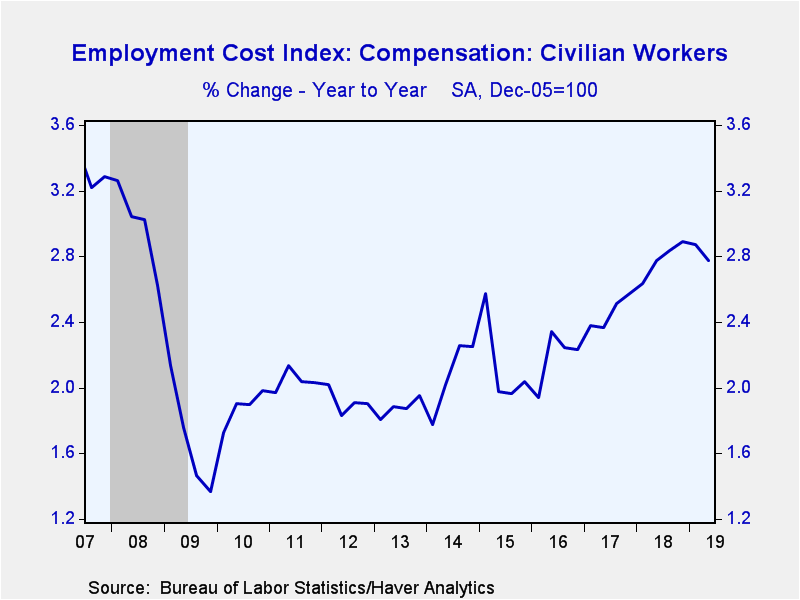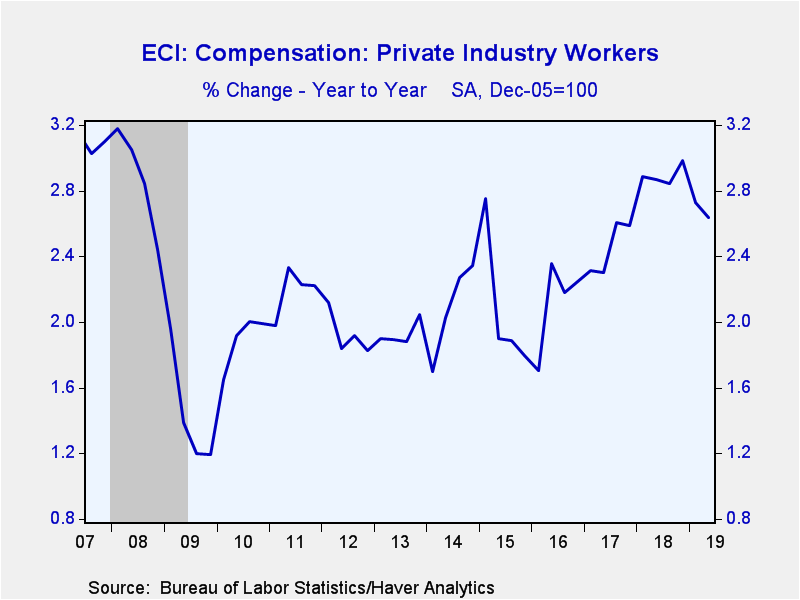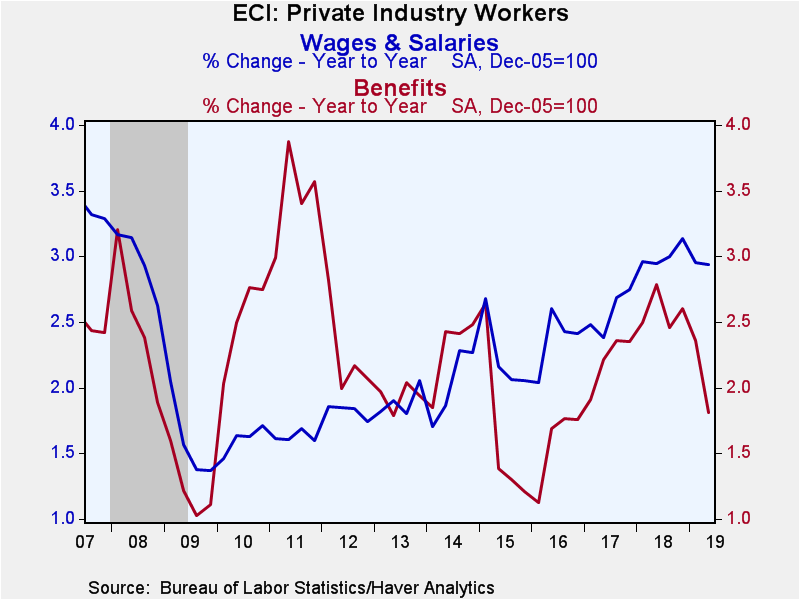 Global| Jul 31 2019
Global| Jul 31 2019U.S. Employment Costs Ease Slightly in Q2
by:Sandy Batten
|in:Economy in Brief
Summary
The employment cost index (ECI) for civilian workers rose 0.6% q/q in 2019 Q2, down slightly from a 0.7% quarterly rise in Q1. This was the slowest pace of compensation gains since 2017 Q4. The increase was slightly below expectations [...]
The employment cost index (ECI) for civilian workers rose 0.6% q/q in 2019 Q2, down slightly from a 0.7% quarterly rise in Q1. This was the slowest pace of compensation gains since 2017 Q4. The increase was slightly below expectations of a 0.7% q/q rise from the Action Economics Forecast Survey. The Q2 slowdown lowered the y/y growth of total compensation to 2.7% from 2.8% in Q1, the second consecutive quarter in which the y/y rate has eased. Wage and salaries rose 0.7% (2.9% y/y), the same quarterly increase as in Q1 while benefits for civilian workers slowed to a 0.5% q/q gain (2.3% y/y) in Q2 after a 0.7% q/q rise in Q1. Civilian workers include those in private industry and in state and local governments, but not in the federal government.
Total compensation gains in private industry slowed in Q2, rising 0.5% q/q (2.6% y/y) after quarterly increases of 0.7% in each of the previous two quarters. This was the slowest pace of quarterly advance since 2017 Q4. The 2.6% y/y increase was also the slowest annual pace since 2017 Q4 and down from a recent high of 3.0% in 2018 Q4. Compensation growth slowed in both goods-producing and service-producing industries in Q2. Goods-producing compensation rose 0.7% q/q, down from a 0.9% q/q gain in Q1. The slowdown was led by manufacturing (0.6% q/q in Q2 vs 0.9% q/q in Q1). The rise in service-producing compensation was unchanged at 0.6% q/q in Q2. About half of the service-producing subsectors experience a pickup in the pace of compensation gains in Q2 with half experiencing decline. Of note, compensation growth in the information sector declined (-1.0% q/q vs +0.8%) and financial activities compensation experienced a sharp slowdown (0.2% q/q vs 0.9%). In contrast, professional and business services compensation jumped up 0.9% q/q in Q2 from a modest 0.3% gain in Q1.
Wage and salary gains within private industry slowed to 0.6% q/q in Q2 from a 0.7% q/q rise in Q1, with the y/y pace of advance unchanged at 3.0%. The pace of increase in both goods-producing and service-production wages slowed in Q2--to 0.7% q/q from 0.8% in goods and to 0.6% q/q from 0.7% in services. In the goods sector, manufacturing wage gains slowed to 0.7% q/q from 0.9% in Q1 while construction wage gains picked up to 0.9% q/q from 0.7%. In the services sector, wage gains slowed markedly in transportation (0.5% q/q vs 1.3%), information (0.5% q/q vs 1.0%) and finance (-0.1% q/q vs 1.0%).
Private industry benefits slowed to 0.4% q/q in Q2 from 0.5% q/q in Q1 with the rate of y/y advance slowing markedly to 1.8% from 2.4%. This is the slowest pace of annual advance since 2016 Q4. The rise in benefits in the goods-producing sector slowed to 0.6% q/q in Q2 from 0.9% in Q1 while the advance of benefits in the service-producing sector was unchanged at 0.4% q/q.
The employment cost index figures are available in Haver's USECON database. Consensus estimates from the Action Economics survey are in Haver's AS1REPNA database.
Sandy Batten
AuthorMore in Author Profile »Sandy Batten has more than 30 years of experience analyzing industrial economies and financial markets and a wide range of experience across the financial services sector, government, and academia. Before joining Haver Analytics, Sandy was a Vice President and Senior Economist at Citibank; Senior Credit Market Analyst at CDC Investment Management, Managing Director at Bear Stearns, and Executive Director at JPMorgan. In 2008, Sandy was named the most accurate US forecaster by the National Association for Business Economics. He is a member of the New York Forecasters Club, NABE, and the American Economic Association. Prior to his time in the financial services sector, Sandy was a Research Officer at the Federal Reserve Bank of St. Louis, Senior Staff Economist on the President’s Council of Economic Advisors, Deputy Assistant Secretary for Economic Policy at the US Treasury, and Economist at the International Monetary Fund. Sandy has taught economics at St. Louis University, Denison University, and Muskingun College. He has published numerous peer-reviewed articles in a wide range of academic publications. He has a B.A. in economics from the University of Richmond and a M.A. and Ph.D. in economics from The Ohio State University.










